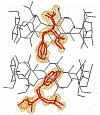Department of Chemistry
Document Type
Article
Date of this Version
May 1986
Abstract
Biphenylene:tetracyanobenzene (BPN:TCNB), C12H8:C10H2N4, crystallizes in a monoclinic lattice, space group P21/a, Z = 2, with a = 15.215(2) Å, b = 7.260(1) Å, c = 7.573(1) Å, β = 90.05(1)° at 296 K. The BPN donor and TCNB acceptor molecules form two symmetry-related mixed linear [001] stacks with the donor and acceptor molecular planes tilted to each other (within the individual stacks) at an angle of Φ = 7.6°. Biphenylene:pyromellitic-dianhydride (BPN:PMDA), C12H8:C10H2O6, crystallizes in two different monoclinic modifications, both space group P21/a, Z = 2, one red, and the other black. The red form (stable above ~400 K) with a = 9.280(1) Å, b = 11.869(2) Å, c = 7.293(1) Å, β = 98.68(2)° at ~120 K, exhibits mixed linear stacks (Φ = 4.1°). The lattice parameters of the black form (stable below ~400 K) are a = 13.368(1) Å, b = 5.809(1) Å, c = 10.443(1) Å, β = 102.30(1)° at ~120 K, and a = 13.450(2) Å, b = 5.917(1) Å, c = 10.464(2) Å, β = 101.82(2)° at 296 K. Its structure also can be viewed as a mixed linear stacking (Φ = 9.9°), but it displays exceptionally little intrastack molecular overlap. Instead, considerable two dimensional interactions among the donors and among the acceptors can be concluded. Single crystals of all three complexes, obtained by the plate sublimation technique, were optically characterized by their charge transfer absorption edges. These are analyzed in terms of the molecular parameters electron affinity and ionization energy. For BPN:TCNB an intrastack and an interstack CT-absorption edge can be distinguished.


Comments
Published in The Journal of Chemical Physics (May 1, 1986) Volume 84, Issue 9, pp. 5162-5170. doi:10.1063/1.450669 The Journal of Chemical Physics is copyrighted by The American Institute of Physics. Used by permission.